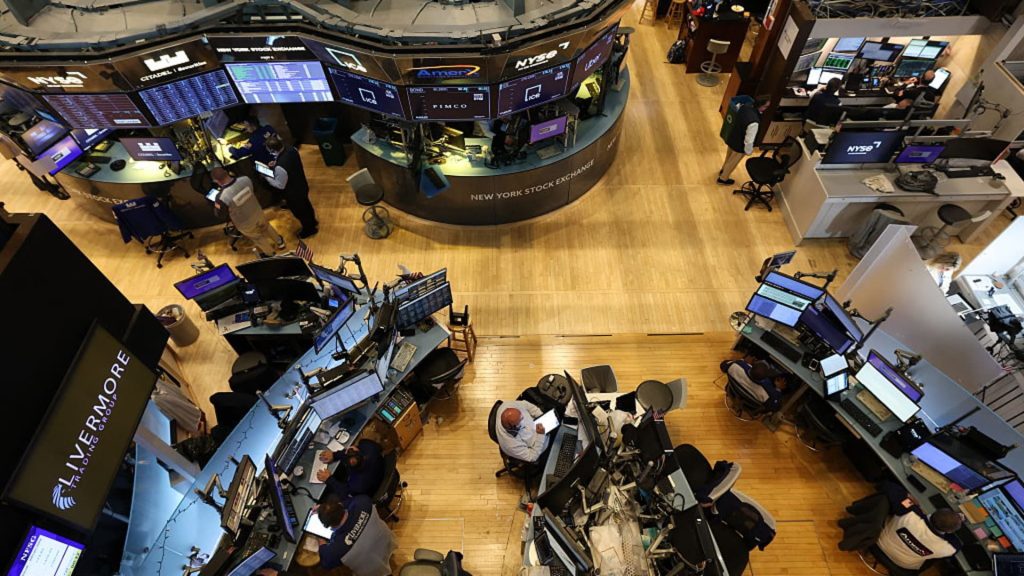Navigating the Tariff Terrain: A Look at Market Reactions and Future Uncertainty
The stock market continues to tread cautiously as investors digest the latest round of tariff announcements from President Donald Trump. Early Wednesday trading saw minimal movement in stock futures, indicating a wait-and-see approach as market participants assess the potential ramifications of these trade policies. This article will delve into the recent market performance, analyze the impact of the new tariffs, and explore the potential future implications for the global economy.
(Image of traders on the NYSE floor)
Traders working on the floor of the New York Stock Exchange (NYSE) at the opening bell.
Market Overview: A Day of Restraint
On Wednesday morning, futures tied to the Dow Jones Industrial Average showed a modest increase of 23 points, or 0.05%. S&P 500 futures edged up by 0.02%, while Nasdaq 100 futures remained relatively flat. These figures suggest a period of consolidation following the previous day’s trading session, which saw mixed results across the major indices.
During Tuesday’s regular session, the S&P 500 dipped slightly by 0.07%, while the Nasdaq Composite managed a small gain of 0.03%. The Dow Jones Industrial Average, however, experienced a more significant decline of nearly 0.4%. This divergence in performance underscores the complex and often unpredictable nature of market reactions to geopolitical and economic developments.
Global markets also displayed mixed reactions. The Nikkei 225 in Japan, South Korea’s Kospi, and Europe’s Stoxx 600 index posted modest gains, indicating a degree of resilience in the face of the newly announced tariffs. However, the overall sentiment remained cautious, reflecting the inherent uncertainties associated with trade policy shifts.
Trump’s Tariff Offensive: A Breakdown
President Trump’s recent tariff announcements have reignited concerns about the future of global trade relations. On Tuesday, he affirmed his decision to impose tariffs on 14 countries, including key economic partners such as Japan and South Korea. These new tariff rates, ranging from 25% to 40%, are scheduled to take effect on August 1, adding a layer of urgency to the situation.
In addition to the broad tariffs, Trump also announced a 50% levy on copper imports, signaling a willingness to target specific sectors. Furthermore, he hinted at the possibility of imposing tariffs of up to 200% on pharmaceuticals imported into the U.S., although he indicated a grace period of approximately one to one-and-a-half years before these duties would be implemented.
These aggressive trade measures have sparked considerable debate among economists and policymakers. Proponents argue that tariffs can protect domestic industries, encourage local production, and strengthen a nation’s bargaining position in trade negotiations. Critics, on the other hand, contend that tariffs can lead to higher prices for consumers, reduced competitiveness for businesses, and retaliatory measures from other countries, ultimately harming the global economy.
Expert Analysis: Navigating the Volatility
According to Scott Helfstein, head of investment strategy at Global X, “The tariff announcement was a reminder that markets are not out of the woods. The White House has not really achieved their goals on trade, and that could be a continued source of volatility.” Helfstein’s analysis highlights the ongoing uncertainty surrounding trade policy and its potential to disrupt market stability.
His perspective underscores the importance of remaining vigilant and adaptable in the face of evolving geopolitical dynamics. Investors must carefully monitor trade negotiations, assess the potential impact of tariffs on specific industries, and adjust their portfolios accordingly.
The Federal Reserve’s Role: A Balancing Act
In addition to keeping a close watch on tariff policy developments, traders will also be monitoring the release of the Federal Open Market Committee’s (FOMC) minutes from its last meeting. The FOMC plays a crucial role in shaping monetary policy, and its decisions can have a significant impact on market sentiment and economic growth.
The Federal Reserve is tasked with maintaining price stability and promoting full employment. In the context of trade tensions, the Fed must carefully weigh the potential inflationary effects of tariffs against the risk of slowing economic growth. This balancing act requires a data-driven approach and a willingness to adjust policy as conditions warrant.
Potential Economic Impacts: A Closer Look
The economic consequences of President Trump’s tariffs are multifaceted and subject to ongoing debate. While the tariffs may provide short-term protection for certain domestic industries, they could also lead to higher costs for consumers and businesses.
Increased Consumer Prices: Tariffs increase the cost of imported goods, which can be passed on to consumers in the form of higher prices. This can reduce purchasing power and potentially lead to decreased consumer spending.
Reduced Business Competitiveness: Tariffs can make it more expensive for businesses to import raw materials and components, reducing their competitiveness in the global market. This could lead to lower profits, reduced investment, and potentially job losses.
Retaliatory Measures: When one country imposes tariffs on another, it often leads to retaliatory measures. This can result in a trade war, where multiple countries impose tariffs on each other, disrupting global trade flows and harming the overall economy.
Supply Chain Disruptions: Tariffs can disrupt global supply chains, as businesses are forced to find alternative sources for their raw materials and components. This can lead to delays, increased costs, and uncertainty for businesses.
Impact on Specific Industries: The impact of tariffs will vary across industries. Some industries, such as steel and aluminum, may benefit from tariffs that protect them from foreign competition. However, other industries, such as those that rely on imported materials, may suffer.
Geopolitical Implications: A Shifting Landscape
The tariff policies implemented by the Trump administration have significant geopolitical implications, potentially altering the balance of power and influencing international relations. These actions can:
Strain International Relations: Imposing tariffs on key trading partners can strain diplomatic relationships and create tensions. This can make it more difficult to address other global challenges, such as climate change, terrorism, and pandemics.
Promote Protectionism: The use of tariffs can encourage other countries to adopt protectionist measures, leading to a decline in global trade and economic cooperation. This can undermine the rules-based international order and create a more fragmented world.
Shift Global Supply Chains: Tariffs can prompt businesses to relocate their supply chains to countries that are not subject to tariffs. This can lead to a redistribution of economic activity and influence the geopolitical landscape.
Influence Trade Negotiations: Tariffs can be used as a tool to pressure other countries to make concessions in trade negotiations. However, this approach can be risky, as it can also lead to escalation and trade wars.
Impact National Security: Tariffs can affect national security by impacting industries deemed critical for defense and strategic purposes. This can lead to debates about protecting domestic industries for national security reasons.
Investment Strategies in a Tariff-Driven Market
Navigating the complexities of a market influenced by tariff policies requires a strategic and adaptable investment approach. Investors should consider the following strategies:
Diversification: Diversifying portfolios across different asset classes and geographic regions can help mitigate the risks associated with tariffs. This approach can reduce exposure to specific industries or countries that may be negatively impacted by trade policies.
Focus on Domestic Companies: Investing in domestic companies that are less reliant on international trade can provide a buffer against the negative effects of tariffs. These companies may benefit from increased demand as consumers shift their spending towards locally produced goods and services.
Value Investing: Identifying undervalued companies with strong fundamentals can be a sound strategy in a volatile market. These companies may be well-positioned to weather the storm of trade tensions and emerge stronger in the long run.
Defensive Stocks: Consider investing in defensive stocks, such as those in the healthcare, utilities, and consumer staples sectors. These companies tend to be less sensitive to economic fluctuations and can provide stability during periods of uncertainty.
Cash Reserves: Maintaining a healthy cash reserve can provide flexibility to take advantage of investment opportunities that may arise during market downturns. This also offers a cushion against potential losses in a volatile environment.
Long-Term Perspective: Beyond the Tariff Headlines
While the immediate impact of tariffs can be significant, it’s crucial to maintain a long-term perspective. Trade policies are subject to change over time, and economies have a remarkable capacity to adapt to new realities.
Historical Context: Examining historical episodes of trade protectionism can provide valuable insights into the potential long-term effects of tariffs. These historical examples can help investors and policymakers better understand the potential risks and rewards of different trade policies.
Innovation and Adaptability: The private sector is often able to innovate and adapt to changing market conditions. Companies can find new ways to source materials, streamline production processes, and reach new markets, even in the face of trade barriers.
Global Cooperation: Ultimately, fostering greater global cooperation and reducing trade barriers can lead to greater economic prosperity for all countries. International organizations such as the World Trade Organization (WTO) play a critical role in promoting free and fair trade.
Policy Flexibility: Policymakers need to remain flexible and adaptable in their approach to trade policy. They should be prepared to adjust tariffs and other trade measures as circumstances change and new information becomes available.
Conclusion: Navigating Uncertainty with Diligence
The current market landscape is characterized by uncertainty, as investors grapple with the implications of President Trump’s tariff policies. While the short-term impact of these tariffs may be disruptive, it’s important to maintain a long-term perspective and adopt a strategic investment approach.
By diversifying portfolios, focusing on domestic companies, and maintaining a healthy cash reserve, investors can navigate the challenges of a tariff-driven market. Additionally, it’s crucial to monitor trade negotiations, assess the potential impact of tariffs on specific industries, and remain adaptable in the face of evolving geopolitical dynamics.
Ultimately, the future of global trade relations remains uncertain, but by staying informed and adopting a prudent approach, investors can position themselves for success in the long run.





